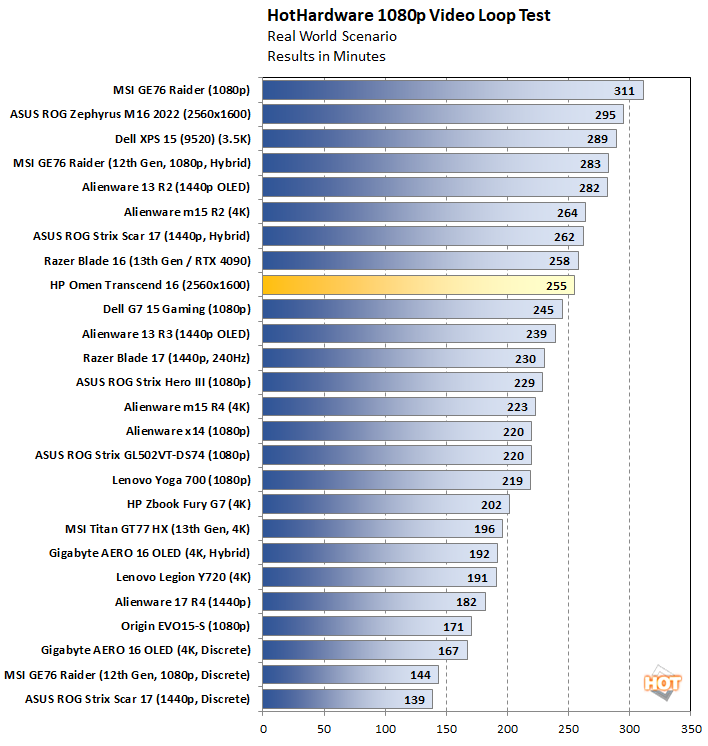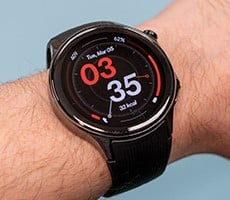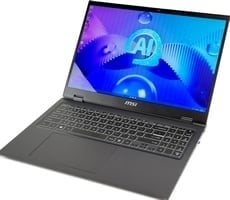HP Omen Transcend 16 Battery Life
We run a custom 1080p HD video loop test developed in-house, to evaluate battery life with notebooks and laptops. In all tests, Windows Quiet Hours / Focus Assist has been enabled and the displays are calibrated with lux meters on pure white screens to as close to 115 lux as possible. For the average laptop this is somewhere between a 40-60 percent brightness setting.
Reducing the brightness slider to 36% resulted in 115 lux at the center of the Omen Transcend 16 laptop. At that setting, the machine stayed up and running for 255 minutes (4 hours and 15 minutes) in our home-brewed battery life video run-down test. While not spectacular in and of itself, that's fairly decent for a larger format gaming laptop.
This result was obtained on the laptop's baseline 6-cell / 97Wh battery that comes configured with the
custom SKU at Best Buy. That's what my unit came with, anyway—Best Buy's listing indicates that it ships with a 4-cel / 70-Wh battery, but that's either incorrect or I got extremely lucky. If purchasing a custom config from HP, the option to upgrade the battery pack to a 6-cell / 97Wh unit costs $30 extra and is required if opting for the mini LED display.
Not surprisingly, the Omen Transcend 16 petered out much faster in PCMark's battery gaming test, lasting just 91 minutes (1 hour and 31 minutes). That's at least enough time to get in a spirited gaming match, though gamers will obviously want to connect the laptop to a wall outlet for extended sessions and top-end performance.
HP Omen Transcend 16 Thermal And Acoustic Performance
Should you ever need to, it's a fairly straightforward process to remove the bottom cover and access this machine's internal hardware—it's just a matter of removing six screws (P00 Phillips) and then carefully prying it off.

HP earns itself some geek points by posting a 37-minute
YouTube video that demonstrates how to open the laptop and service various components. The one thing I'll add is that it's not necessary to uncomfortably flex the bottom cover before removing it. I used
a plastic spudger and it popped right off.
If nothing else, you may want to crack the Omen Transcend 16 open every so often to ensure its dual fans are free from dust and debris. A quick blast of compressed air should to the trick.
Next, we fired up 3DMark's built-in stress test to get things cooking and measure fan noise. Under this kind of load and with the noise meter relatively close (within a foot) of the top vent slab, fan noise measured between around 44 and 48 decibels. According to Hearing Health Foundation, the 30-50 decibel range ranks as "average room noise." To my ears, it's a noticeable albeit soft whir. Should the fans spin up to full blast, either manually or after an extended load, the Omen Transcend 16's fan noise ramp up to around 60 decibels—considerably louder, though just short of being obnoxious.
The cooling setup on the Omen Transcend 16 does a good job of dissipating heat. A combination of dual fans, heatsinks, heatpipes, and generous ventilation (including a very large ventilated cutout in the bottom) combine to prevent the laptop from becoming overly hot to the touch, even at full load.
Temp readings on the main surface of the laptop topped out at around 111 degrees Fahrenheit (~43.4C). That's coming from the hottest spot, which is a little off-center to the right on the keyboard area. Temp measurements on most other spots were in the 90s. And the hottest measurements came from the vents—when aiming the dual-layer temp meter into the bottom vents, the high-temp mark was 137F (~58.3C).
Overall, the Omen Transcend 16 is comfortable to the touch regardless of the CPU and/or GPU load.
HP Omen Transcend 16 Takeaways And Conclusion
Gaming and creator laptops are much more refined than they were even just a few years ago. These once big and bulky machines have transformed into lighter and sleeker form factors, and the crop of 16-inch designs is especially interesting. It's what tempted to me consider jumping ship from 17.3-inch territory, which I ultimately did.
HP's Omen Transcend 16 is the model that finally won me over. And specifically, the Ceramic White color option grabbed my attention, pulling me in like a tractor beam with a clean design and powerful hardware. It's just a shame that HP limits what configurations are available in this Ceramic White trim.
The biggest bragging point of the Omen Transcend 16 is the option for a mini LED display, but that's only available with the Shadow Black color option. And based on the demo model at our local Best Buy, it's a fingerprint magnet. That's not the only seemingly arbitrary limitation, though. HP also reserves the GeForce RTX 4070 GPU option for the Shadow Black trim, save for a special
SKU at Best Buy (6537003).
That SKU is what's being reviewed here. I picked it up on sale for $1,899.99 (quite the deal at the time, actually), having ultimately decided I'd rather spend less for the Ceramic White chassis than to spring for a Shadow Black config with a mini LED display on HP's website. If going the mini LED route, pricing starts at $2,589.99 (before any coupon codes), which gets the same CPU, GPU, RAM, and storage specs as this Best Buy config, and a the same 6-cell battery.
At the time of this publication, pricing on this SKU is back up closer to its original
list price at $2,199.99. That puts it in competition with laptops like the ASUS ROG Zephyrus M16 and Lenovo Legion Slim 7i, both of which offer similar specs for a little less money. And for those who like to go big, the similarly-equipped
ASUS ROG Strix 17 is roughly the same price.
That said, it's easier to recommend this HP SKU if you can nab it on sale like I did. The combination of a 13th Gen Core i9-13900HX processor, GeForce RTX 4070 GPU, 16GB of RAM, 1TB of fast PCIe 4.0 SSD storage, and 16-inch WQXGA (2560x1600) display with a 240Hz refresh rate in a stunning white package for under $2K is alluring.
The waters become muddied when this laptop sells for its full $2,199.99 list price at Best Buy. Using a coupon code available at the time of this writing (10GAMER2023), the price before tax for the Shadow Black config with a mini LED display at HP's website drops to $2,330.00. So for $30 more, you can get a much brighter display, bigger capacity battery, and better value proposition, but not the Ceramic White color scheme.
This is why we mentioned theme of compromises earlier in this review. It's also notable that features like G-Sync, HDR support, and per-key RGB lighting are all absent in this config as tested. We also wish the USB-A ports were of the faster Gen 2 (10Gbps) variety, rather than Gen 1 (5Gbps), but that's a minor quibble.
So what's the verdict? The HP Omen Transcend 16 is an absolutely gorgeous and fast laptop for gamers and creators alike. It has a large touchpad, zoned RGB lighting (on this SKU), high-end hardware, and excellent cooling. It's also easy to perform certain DIY upgrades and repairs.
The only real knock with this particular SKU is the price. At $2,199.99, it really needs to offer the mini LED display option for a no-brainer recommendation. Otherwise, see if you can catch it on sale—at $1,899.99, it's just $200 more than the baseline config on HP's website (with a slower Core i7-13700HX CPU and GeForce R TX 4060 GPU). There's also a solid deal on an RTX 4060 equipped model
here at Amazon.
As it stands, we still recommend adding this to your list of gaming laptop candidates. However, if you're not as enamored with the Ceramic White trim as I am, spend just at tiny bit extra for the mini LED display option
on HP's website. And/or perhaps look at the other 16-inch options mentioned above.
















